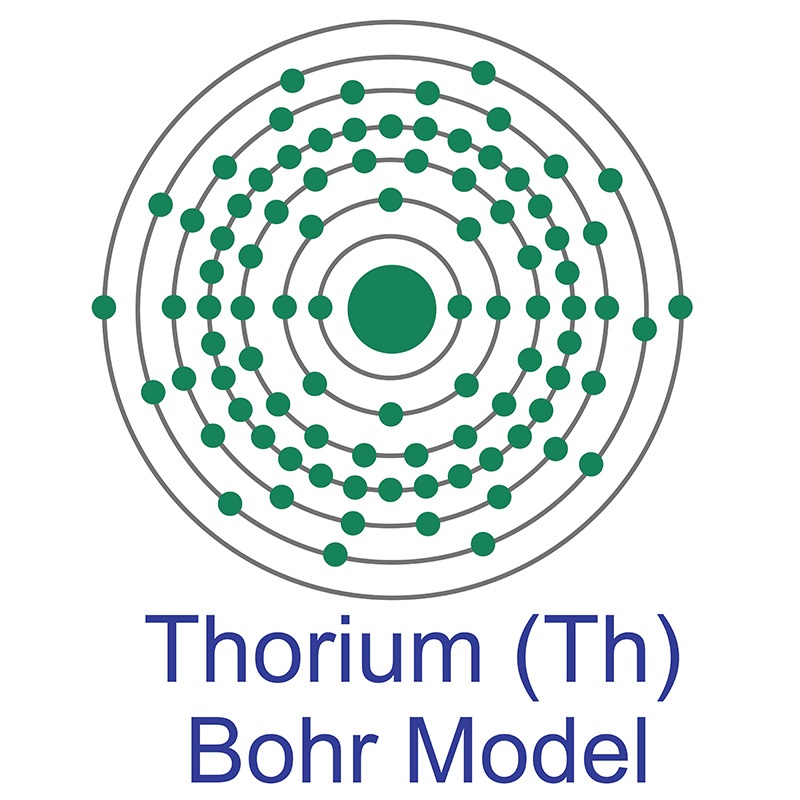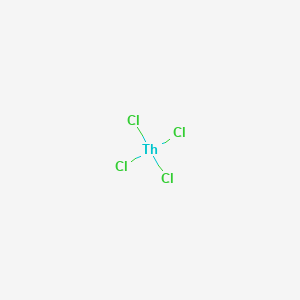SECTION 1. IDENTIFICATION
Product Name: Thorium Chloride
Product Number: All applicable American Elements product codes, e.g. TH-CL-04
, TH-CL-04
, TH-CL-04
, TH-M-03-CL
CAS #: 10026-08-1
Relevant identified uses of the substance: Scientific research and development
Supplier details:
American Elements
10884 Weyburn Ave.
Los Angeles, CA 90024
Tel: +1 310-208-0551
Fax: +1 310-208-0351
Emergency telephone number:
Domestic, North America: +1 800-424-9300
International: +1 703-527-3887
SECTION 2. HAZARDS IDENTIFICATION
Hazard description:
Xn Harmful
Information pertaining to particular dangers for man and environment
R 20/22 Harmful by inhalation and if swallowed.
R 33 Danger of cumulative effects.
Classification system
HMIS ratings (scale 0-4)
(Hazardous Materials Identification System)
HEALTH
FIRE
REACTIVITY
2
0
2
Health (acute effects) = 2
Flammability = 0
Reactivity = 2
SECTION 3. COMPOSITION/INFORMATION ON INGREDIENTS
Chemical characterization:
Description: (CAS#)
Thorium chloride (CAS# 10026-08-1), 100%
Identification number(s):
EINECS Number: 2338450
SECTION 4. FIRST AID MEASURES
Supply patient with fresh air. If not breathing, provide artificial respiration. Keep
patient warm.
Seek immediate medical advice.
In case of skin contact:
Immediately wash with soap and water; rinse thoroughly.
Seek immediate medical advice.
In case of eye contact:
Rinse opened eye for several minutes under running water. Then consult a
doctor.
If swallowed:
Seek immediate medical advice.
SECTION 5. FIREFIGHTING MEASURES
Suitable extinguishing agents
CO2, extinguishing powder or water spray. Fight larger fires with water
spray.
Special hazards caused by the material, its products of combustion or
resulting gases:
In case of fire, the following can be released:
Hydrogen chloride (HCl)
Toxic metal oxide fume
Protective equipment:
Wear self-contained respirator.
Wear fully protective impervious suit.
SECTION 6. ACCIDENTAL RELEASE MEASURES
Person-related safety precautions:
Use personal protective equipment. Keep unprotected persons away.
Ensure adequate ventilation
Measures for environmental protection:
Do not allow material to be released to the environment without proper
governmental permits.
Measures for cleaning/collecting:
Dispose contaminated material as waste according to item 13.
Ensure adequate ventilation.
Additional information:
See Section 7 for information on safe handling
See Section 8 for information on personal protection equipment.
See Section 13 for disposal information.
SECTION 7. HANDLING AND STORAGE
Handling
Information for safe handling:
Keep container tightly sealed.
Store in cool, dry place in tightly closed containers.
Ensure good ventilation at the workplace.
Information about protection against explosions and fires:
No special measures required.
Storage
Requirements to be met by storerooms and receptacles:
No special requirements.
Information about storage in one common storage facility: Not required.
Further information about storage conditions:
Keep container tightly sealed.
Store in cool, dry conditions in well-sealed containers.
SECTION 8. EXPOSURE CONTROLS/PERSONAL PROTECTION
Additional information about design of technical systems:
Properly operating chemical fume hood designed for hazardous chemicals
and having an average face velocity of at least 100 feet per minute.
Components with limit values that require monitoring at the workplace:
Not required.
Additional information: No data
Personal protective equipment
General protective and hygienic measures
The usual precautionary measures for handling chemicals should be
followed.
Keep away from foodstuffs, beverages and feed.
Remove all soiled and contaminated clothing immediately.
Wash hands before breaks and at the end of work.
Breathing equipment:
Use suitable respirator when high concentrations are present.
Protection of hands: Impervious gloves
Eye protection: Safety glasses
Body protection: Protective work clothing.
SECTION 9. PHYSICAL AND CHEMICAL PROPERTIES
General Information
Form: Crystalline
Color: White
Odor: Odorless
Melting point/Melting range: 768-772°C (1414-1422°F)
Boiling point/Boiling range: 928°C (1702°F) ((dec))
Sublimation temperature / start: No data available
Flash point: N/A
Ignition temperature: No data available
Decomposition temperature: No data available
Danger of explosion: Product does not present an
explosion hazard.
Explosion limits:
Lower: No data available
Upper: No data available
Vapor pressure: No data available
Density at 20°C (68°F): 4.59 g/cm3
Solubility in / Miscibility with
Water: Soluble
SECTION 10. STABILITY AND REACTIVITY
Thermal decomposition / conditions to be avoided:
Decomposition will not occur if used and stored according to
specifications.
Materials to be avoided: None known.
Dangerous reactions No dangerous reactions known
Dangerous products of decomposition:
Hydrogen chloride (HCl)
Toxic metal oxide fume
SECTION 11. TOXICOLOGICAL INFORMATION
Acute toxicity:
Primary irritant effect:
on the skin: Irritant to skin and mucous membranes.
on the eye: Irritating effect.
Sensitization: No sensitizing effects known.
Subacute to chronic toxicity:
Exposure to thorium may cause gastrointestinal distress, skin, eye, or
lung irritation. Radiation damage and cancers of bone, blood, liver or
kidney may result.
Additional toxicological information:
To the best of our knowledge the acute and chronic toxicity of this
substance is not fully known.
SECTION 12. ECOLOGICAL INFORMATION
General notes:
Do not allow material to be released to the environment without proper
governmental permits.
SECTION 13. DISPOSAL CONSIDERATIONS
Product:
Recommendation
Consult official regulations to ensure proper disposal.
Not a solid waste by RCRA exclusion, see 40CFR261.4.(a).(4).
See 10CFR part 40 for disposal.
Uncleaned packagings:
Recommendation: Disposal must be made according to official regulations.
Recommended cleansing agent: Water, if necessary with cleansing agents.
SECTION 14. TRANSPORT INFORMATION
DOT regulations:
Hazard class: 7
Identification number: UN2910
Proper shipping name (technical
name): RADIOACTIVE MATERIAL, EXCEPTED PACKAGE -
LIMITED QUANTITY OF MATERIAL
Land transport ADR/RID (cross-border)
ADR/RID class: 7 Radioactive material
UN-Number: 2910
Packaging group: -
Description of goods: 2910 RADIOACTIVE MATERIAL, EXCEPTED
PACKAGE - LIMITED QUANTITY OF MATERIAL
Maritime transport IMDG:
IMDG Class: 7
UN Number: 2910
Proper shipping name: RADIOACTIVE MATERIAL, EXCEPTED PACKAGE -
LIMITED QUANTITY OF MATERIAL
Air transport ICAO-TI and IATA-DGR:
ICAO/IATA Class: 7
UN/ID Number: 2910
Proper shipping name: RADIOACTIVE MATERIAL, EXCEPTED PACKAGE -
LIMITED QUANTITY OF MATERIAL
SECTION 15. REGULATORY INFORMATION
Product related hazard informations:
Hazard symbols:
Xn Harmful
Risk phrases:
20/22 Harmful by inhalation and if swallowed.
33 Danger of cumulative effects.
Safety phrases:
9 Keep container in a well-ventilated place.
36/37 Wear suitable protective clothing and gloves.
38 In case of insufficient ventilation, wear suitable respiratory
equipment.
National regulations
All components of this product are listed in the U.S. Environmental
Protection Agency Toxic Substances Control Act Chemical substance
Inventory.
This product contains a chemical known to the state of California to
cause cancer or reproductive toxicity.
Information about limitation of use:
For use only by technically qualified individuals.
The radioactive content of thorium and thorium containing materials is
defined as it's specific activity. The specific activity of naturally
occuring thorium is 0.00000022 curie/gram (8140 Bq/gram) of contained
thorium.
SECTION 16. OTHER INFORMATION
Safety Data Sheet according to Regulation (EC) No. 1907/2006 (REACH). The above information is believed to be correct but does not purport to be all inclusive and shall be used only as a guide. The information in this document is based on the present state of our knowledge and is applicable to the product with regard to appropriate safety precautions. It does not represent any guarantee of the properties of the product. American Elements shall not be held liable for any damage resulting from handling or from contact with the above product. See reverse side of invoice or packing slip for additional terms and conditions of sale. COPYRIGHT 1997-2022 AMERICAN ELEMENTS. LICENSED GRANTED TO MAKE UNLIMITED PAPER COPIES FOR INTERNAL USE ONLY.
 The thorium atom has a radius of 179 pm and a Van der Waals radius of 237 pm. Thorium was first discovered by Jöns Jakob Berzelius in 1829. The name Thorium originates from the Scandinavian god Thor, the Norse god of war and thunder.
The thorium atom has a radius of 179 pm and a Van der Waals radius of 237 pm. Thorium was first discovered by Jöns Jakob Berzelius in 1829. The name Thorium originates from the Scandinavian god Thor, the Norse god of war and thunder.  In its elemental form, thorium has a silvery, sometimes black-tarnished, appearance. It is found in small amounts in most rocks and soils. Thorium is a radioactive element that is currently the best contender for replacing uranium as nuclear fuel for nuclear reactors. It provides greater safety benefits, an absence of non-fertile isotopes, and it is both more available and abundant in the Earth's crust than uranium.
In its elemental form, thorium has a silvery, sometimes black-tarnished, appearance. It is found in small amounts in most rocks and soils. Thorium is a radioactive element that is currently the best contender for replacing uranium as nuclear fuel for nuclear reactors. It provides greater safety benefits, an absence of non-fertile isotopes, and it is both more available and abundant in the Earth's crust than uranium.

